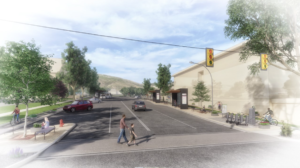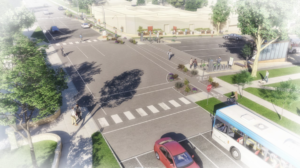Campus Mobility Hub Study – APAUT Award Winner
February 25, 2021 by admin
Policy/Legislative, Urban Planning
Mobility hubs are a new and emerging trend in the US. The Campus Mobility Hub Study pioneered how mobility hubs can be researched, sited, programmed, funded, designed, and developed. The Stakeholder Group included the University of Utah, Salt Lake City, the Veteran’s Administration, the Utah Transit Authority, Wasatch Front Regional Council, and Utah Department of Transportation.
The intent of mobility hubs is to encourage mode shift through hub proximity to destinations and services, connectivity and seamless transfers, user-friendly programming and wayfinding, and increased safety and security by implementing pedestrian priority and placemaking elements. Mobility hubs are meant to integrate a wide range of transportation modes and services, amenities, and technology.
The purpose of the study was to assist the Stakeholder Group in determining optimal locations for mobility hubs within the University of Utah and the surrounding campus. The Study was led by the University of Utah, who was the major funder of the project. However, each of the stakeholders participated financially in the Study.
The Study brought together the stakeholders along with students, employees, and residents to create a framework for future mobility in the region. The study also provided guidance and recommendations for making strategic decisions to balance transportation demand while expanding mobility options for the community.
Since mobility hubs are still in their infancy in respect to design, use, and research in the US, there was a lack of research and depth of case studies to draw from. Therefore, much of the process was an exercise in pioneering the research, siting, programming, and designing of a mobility hub. This required extensive communication between the design team members and the stakeholders to determine the basic needs and goals of the Study. Additionally, the stakeholders for the Study included a diverse group with varying goals and needs for the project. These goals and needs often conflicted or were divergent in nature, but ultimately the Study identified priorities that were consistent among the majority of the stakeholders.
The Study received 7,963 responses during the public outreach portions of the process which came before and after all major project milestones, ensuring that the input would guide each
step of the process. Input was gathered for mobility hub siting, locational needs, methods of transportation to, from, and within the study area, existing conditions, future plans, desired amenities and services, concept designs, preferred scenarios, hub typologies, and other major aspects of the project. These responses came from the many methods utilized by the project team, including online surveys, in-person printed surveys, intercept printed and digital surveys, booth and pop-up events, a virtual open house, email outreach, and an informative website which allowed ongoing feedback.
The study reviewed existing conditions and previous studies and analyzed those studies with collected data from public engagement and other sources to select preferred locations for the mobility hubs. It also associated the best practices and emerging trends from applicable case studies.
Conceptual designs for the preferred locations were created with tailored site-specific program elements. These concepts helped the stakeholders visualize how the preferred hub sites could be developed.
The Study was originally scoped to identify one mobility hub location. However, as the project progressed, it became apparent that the divergent needs of the various stakeholders and because of the size of the project area, multiple hubs were needed. The Study ultimately identified three hub locations and provided conceptual design and programming for each of the three sites.
Additionally, eight micro-mobility hub site locations were identified and programmed.
The project team included Psomas, ALTA Planning and Design, CRSA Architects, and Zions Bank Public Finance.
APA UT – 2020 Award of Merit
Campus Mobility Hub Study
Submitted by Psomas
Vicky Golie, CPSM
Regional Marketing Manager
I just wanted to compliment the team for completing such an incredible, thorough, informative, fantastic report. This report will not only guide the University of Utah, but I believe will guide others across the state or the country, who seek guidelines on how to plan for and implement Campus Mobility Hubs. This is one of the best, most informative reports I have ever read. Great Work!
— Angelo Papastamos
UDOT TravelWise Program Engineer
Recent News
- » Reflecting on the Highlights of Our Spring Conference in Cedar City, Uta
- » Save the Date for the 2024 APA UT Fall Conference in Provo, UT, October 10-11, 2024
- » Saratoga Springs planning for walkable, ‘heart of community’ downtown area
- » These are the 10 reasons Utahns can save the Great Salt Lake, a state official says
- » Experts say lack of condo-building comes down to risk, returns
- » APA UT- Call for Nominations




































